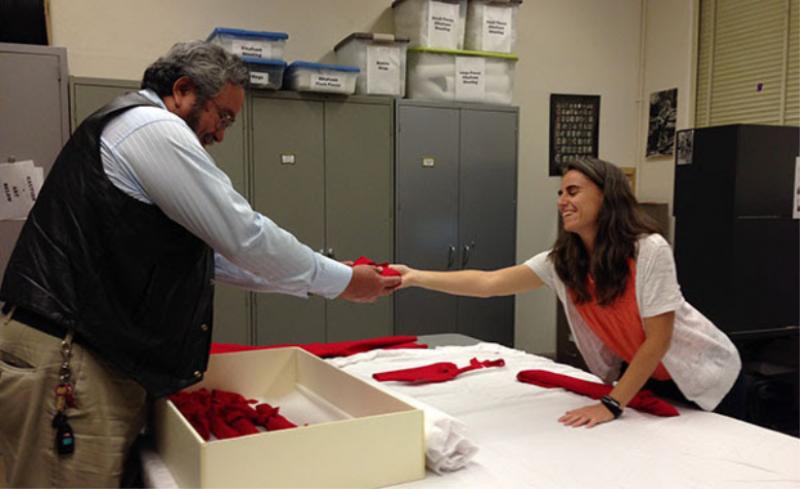Repatriation as a Foundation for Research

Calvin Grinnell and Jen Shannon preparing for the return of sacred items to the Mandan Hidatsa Arikara Nation in 2014. The repatriation consultation that began this process led to a long term research collaboration that includes an oral history project and video documentary, a community-based film project, and a co-authored publication with community members. Photo by Jan Bernstein.
Jen Shannon, Curator & Associate Professor of Cultural Anthropology, University of Colorado Boulder
As I was reading the report from the NAGPRA Community of Practice Summit in March 2019 I paused when I read Issue D: "Participant comments and survey responses highlighted a perception that some museums prioritize a duty to curate collections in perpetuity and make them accessible to researchers over implementing NAGPRA." When the Native American Graves Protection and Repatriation Act (NAGPRA) passed in 1990, many people imagined that collections would be emptied and research would cease. My experience has been the opposite: repatriation has been an excellent foundation for research , led to an increase in knowledge about our collections through consultation, and created a more positive and meaningful experience in the museum for both Indigenous peoples and museum staff. In addition, consultations can lead to museums maintaining more accurate knowledge or intangible culture in perpetuity, if not the tangible culture or material item itself. That's one way to think about it. There are also examples of positive repatriation consultations leading to the acquisition of new collections, like when a replica or newly made item is provided by the tribe.
I have also thought a lot about the idea of museums keeping things in perpetuity and the reasoning behind it, often phrased as "for posterity." I began thinking in terms of the idea that "Posterity is Now" after I read a quote by Robert Janes, former director of the Glenbow Museum. Reflecting on the repatriation of medicine bundles to Blackfoot community members in We are Coming Home: Repatriation and the Restoration of Blackfoot Cultural Confidence (2015: 255), he writes "The museum profession is fond of saying that 'museums keep things for posterity.' By 1998, we had concluded that posterity had arrived – both for the Blackfoot and for the Glenbow." This fundamentally calls into question assumptions about who and what museums are for. Posterity is not (or not only) the general public in an undefined future: it is Indigenous peoples, today. Implementing NAGPRA is essential to this reorientation of the museum and its purpose.
There are also exemplary non-NAGPRA projects that contribute to this reorientation as well. These include collections visits focused on language recovery , digital web portals created in partnership between museums and Native Nations that provide access to museum collections and/or photographic archives, and long term loan programs that bring museum collection items into communities. According to Karl Duncan , director of the Poeh Cultural Center that has a long term loan from the National Museum of the American Indian, bringing these items into the community helps to "bring back these traditions, bring back these reminders, they'll enable Native people, enable Native communities, to be healthier, to be happier. To solve a lot of the problems that we have going on today." Taking Indigenous ways of knowing seriously, we come to understand that heritage work and repatriation are key to maintaining the health and wellbeing of Native communities in the present and future.
So, can we reimagine the museum, alongside Native community members, as a place that enables relations and practices that support community health and well-being? And museum professionals as allies in doing so? What would it mean for your museum to reorient your notion of posterity – to now? Can we see returning Native ancestors/human remains and sacred items as, rather than "emptying museums," actually bringing more knowledge, and sometimes different kinds of items, into the museum? Can we reorient our understanding of repatriation so that it is defined as a way to build relationships that endure and enhance the research we do, as a means to create the conditions for more meaningful experiences for museum staff, originating communities, and the public? How might you explain repatriation to the staff of your museum so that it can be seen as a way to forge new relations and engage in collaborative research?
If you are a museum or staff member that does not have much experience in working directly with Native communities, don't let that be a barrier to reaching out to tribes. Honest, direct, and respectful dialog goes a long way. While not aimed for repatriation consultations, the SAR Museum+Community Guidelines for Collaboration are a brief and helpful resource for preparing museum staff to work with tribes in a museum. In particular, the section on Critical Considerations in the guidelines offers insight and tips for enabling a more positive experience when hosting Native communities in your institution.
Portions of this post were excerpted from "Museum Mantras, Teachings from Indian Country : Posterity is Now; Failure is an Option; and Repatriation is a Foundation for Research" in Science Museums in Transition, edited by Hooley McLaughlin and Judy Diamond (Routledge Press, 2019).


